Report: Developing a Business Idea for Dual-Battery Smartphones
VerifiedAdded on 2020/05/16
|11
|2293
|91
Report
AI Summary
This report proposes a business idea centered around manufacturing dual-battery smartphones to address the growing need for extended power capabilities in the mobile market. The report begins with an executive summary and introduction, highlighting the entrepreneurial gap related to limited smartphone battery life. It then outlines the benefits of the business, including increased social cohesion and job creation, followed by a detailed business model utilizing the business model canvas. Critical success factors, such as the use of modern digital technologies, employee motivation, and legal compliance, are discussed. The report evaluates both market and commercial feasibility, considering the target market, competitors, required investment, and potential revenue streams. The conclusion emphasizes the importance of feasibility studies for business success. Finally, references and an appendix with a business model canvas are included.
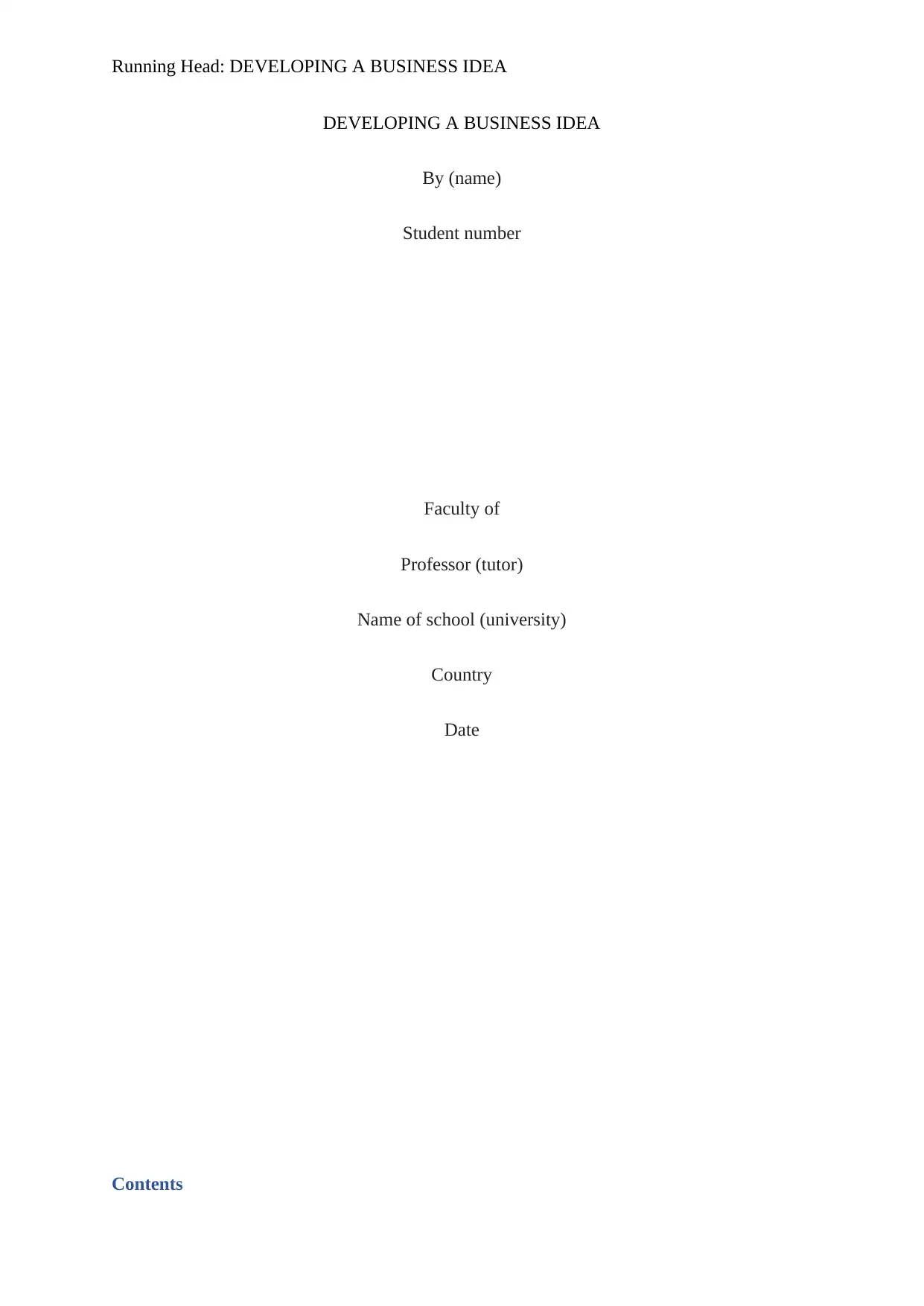
Running Head: DEVELOPING A BUSINESS IDEA
DEVELOPING A BUSINESS IDEA
By (name)
Student number
Faculty of
Professor (tutor)
Name of school (university)
Country
Date
Contents
DEVELOPING A BUSINESS IDEA
By (name)
Student number
Faculty of
Professor (tutor)
Name of school (university)
Country
Date
Contents
Paraphrase This Document
Need a fresh take? Get an instant paraphrase of this document with our AI Paraphraser
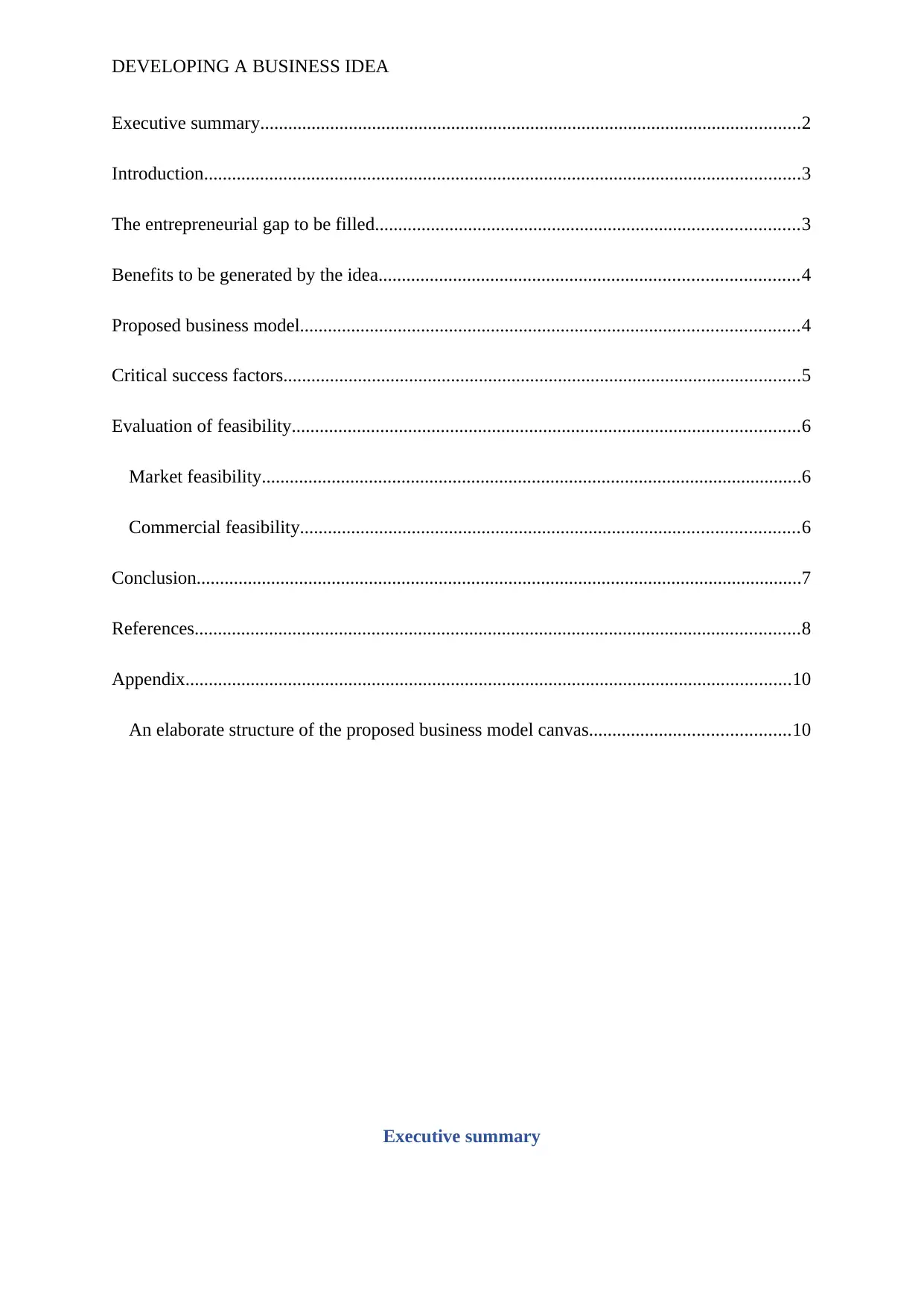
DEVELOPING A BUSINESS IDEA
Executive summary....................................................................................................................2
Introduction................................................................................................................................3
The entrepreneurial gap to be filled...........................................................................................3
Benefits to be generated by the idea..........................................................................................4
Proposed business model...........................................................................................................4
Critical success factors...............................................................................................................5
Evaluation of feasibility.............................................................................................................6
Market feasibility....................................................................................................................6
Commercial feasibility...........................................................................................................6
Conclusion..................................................................................................................................7
References..................................................................................................................................8
Appendix..................................................................................................................................10
An elaborate structure of the proposed business model canvas...........................................10
Executive summary
Executive summary....................................................................................................................2
Introduction................................................................................................................................3
The entrepreneurial gap to be filled...........................................................................................3
Benefits to be generated by the idea..........................................................................................4
Proposed business model...........................................................................................................4
Critical success factors...............................................................................................................5
Evaluation of feasibility.............................................................................................................6
Market feasibility....................................................................................................................6
Commercial feasibility...........................................................................................................6
Conclusion..................................................................................................................................7
References..................................................................................................................................8
Appendix..................................................................................................................................10
An elaborate structure of the proposed business model canvas...........................................10
Executive summary
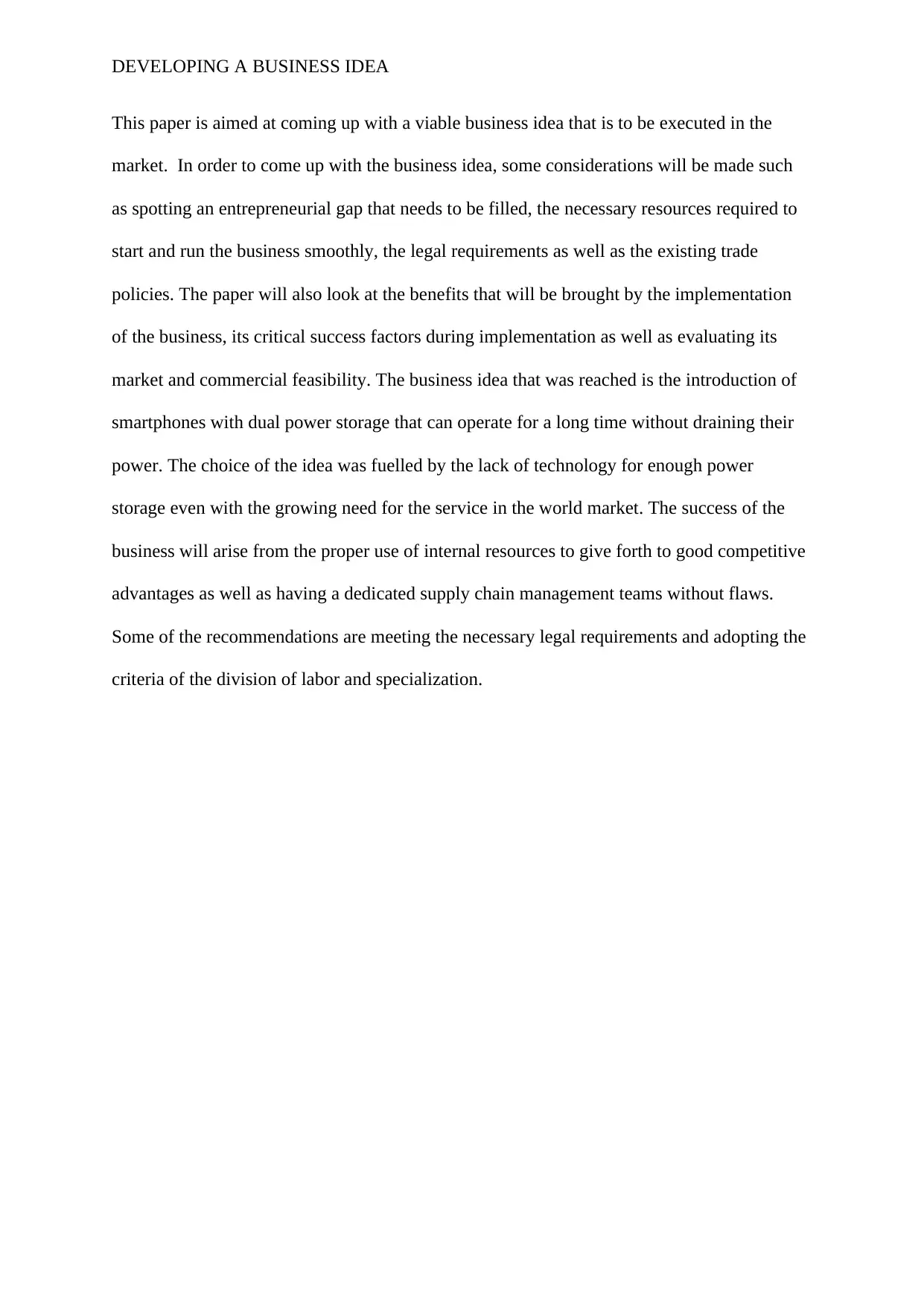
DEVELOPING A BUSINESS IDEA
This paper is aimed at coming up with a viable business idea that is to be executed in the
market. In order to come up with the business idea, some considerations will be made such
as spotting an entrepreneurial gap that needs to be filled, the necessary resources required to
start and run the business smoothly, the legal requirements as well as the existing trade
policies. The paper will also look at the benefits that will be brought by the implementation
of the business, its critical success factors during implementation as well as evaluating its
market and commercial feasibility. The business idea that was reached is the introduction of
smartphones with dual power storage that can operate for a long time without draining their
power. The choice of the idea was fuelled by the lack of technology for enough power
storage even with the growing need for the service in the world market. The success of the
business will arise from the proper use of internal resources to give forth to good competitive
advantages as well as having a dedicated supply chain management teams without flaws.
Some of the recommendations are meeting the necessary legal requirements and adopting the
criteria of the division of labor and specialization.
This paper is aimed at coming up with a viable business idea that is to be executed in the
market. In order to come up with the business idea, some considerations will be made such
as spotting an entrepreneurial gap that needs to be filled, the necessary resources required to
start and run the business smoothly, the legal requirements as well as the existing trade
policies. The paper will also look at the benefits that will be brought by the implementation
of the business, its critical success factors during implementation as well as evaluating its
market and commercial feasibility. The business idea that was reached is the introduction of
smartphones with dual power storage that can operate for a long time without draining their
power. The choice of the idea was fuelled by the lack of technology for enough power
storage even with the growing need for the service in the world market. The success of the
business will arise from the proper use of internal resources to give forth to good competitive
advantages as well as having a dedicated supply chain management teams without flaws.
Some of the recommendations are meeting the necessary legal requirements and adopting the
criteria of the division of labor and specialization.
⊘ This is a preview!⊘
Do you want full access?
Subscribe today to unlock all pages.

Trusted by 1+ million students worldwide
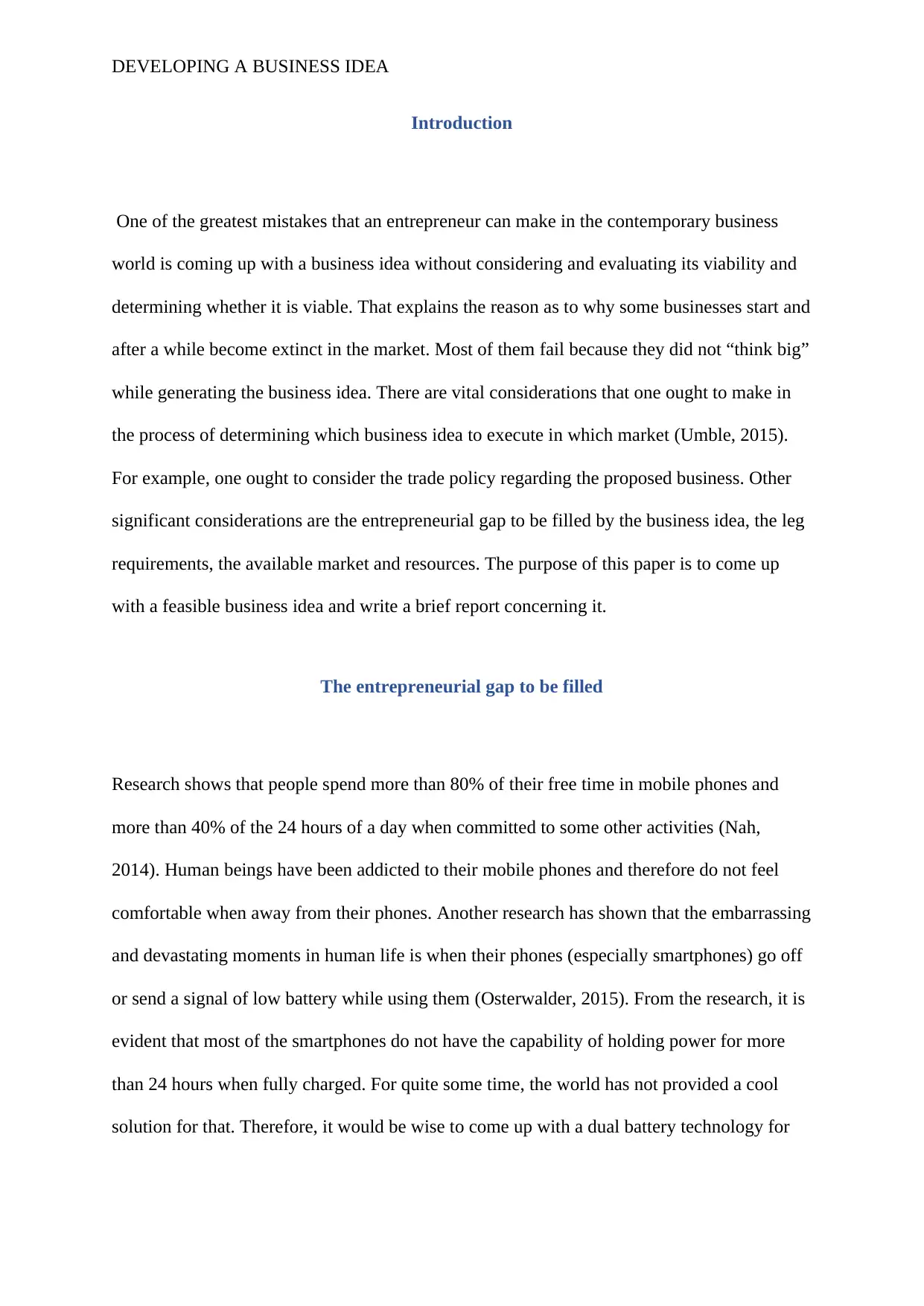
DEVELOPING A BUSINESS IDEA
Introduction
One of the greatest mistakes that an entrepreneur can make in the contemporary business
world is coming up with a business idea without considering and evaluating its viability and
determining whether it is viable. That explains the reason as to why some businesses start and
after a while become extinct in the market. Most of them fail because they did not “think big”
while generating the business idea. There are vital considerations that one ought to make in
the process of determining which business idea to execute in which market (Umble, 2015).
For example, one ought to consider the trade policy regarding the proposed business. Other
significant considerations are the entrepreneurial gap to be filled by the business idea, the leg
requirements, the available market and resources. The purpose of this paper is to come up
with a feasible business idea and write a brief report concerning it.
The entrepreneurial gap to be filled
Research shows that people spend more than 80% of their free time in mobile phones and
more than 40% of the 24 hours of a day when committed to some other activities (Nah,
2014). Human beings have been addicted to their mobile phones and therefore do not feel
comfortable when away from their phones. Another research has shown that the embarrassing
and devastating moments in human life is when their phones (especially smartphones) go off
or send a signal of low battery while using them (Osterwalder, 2015). From the research, it is
evident that most of the smartphones do not have the capability of holding power for more
than 24 hours when fully charged. For quite some time, the world has not provided a cool
solution for that. Therefore, it would be wise to come up with a dual battery technology for
Introduction
One of the greatest mistakes that an entrepreneur can make in the contemporary business
world is coming up with a business idea without considering and evaluating its viability and
determining whether it is viable. That explains the reason as to why some businesses start and
after a while become extinct in the market. Most of them fail because they did not “think big”
while generating the business idea. There are vital considerations that one ought to make in
the process of determining which business idea to execute in which market (Umble, 2015).
For example, one ought to consider the trade policy regarding the proposed business. Other
significant considerations are the entrepreneurial gap to be filled by the business idea, the leg
requirements, the available market and resources. The purpose of this paper is to come up
with a feasible business idea and write a brief report concerning it.
The entrepreneurial gap to be filled
Research shows that people spend more than 80% of their free time in mobile phones and
more than 40% of the 24 hours of a day when committed to some other activities (Nah,
2014). Human beings have been addicted to their mobile phones and therefore do not feel
comfortable when away from their phones. Another research has shown that the embarrassing
and devastating moments in human life is when their phones (especially smartphones) go off
or send a signal of low battery while using them (Osterwalder, 2015). From the research, it is
evident that most of the smartphones do not have the capability of holding power for more
than 24 hours when fully charged. For quite some time, the world has not provided a cool
solution for that. Therefore, it would be wise to come up with a dual battery technology for
Paraphrase This Document
Need a fresh take? Get an instant paraphrase of this document with our AI Paraphraser
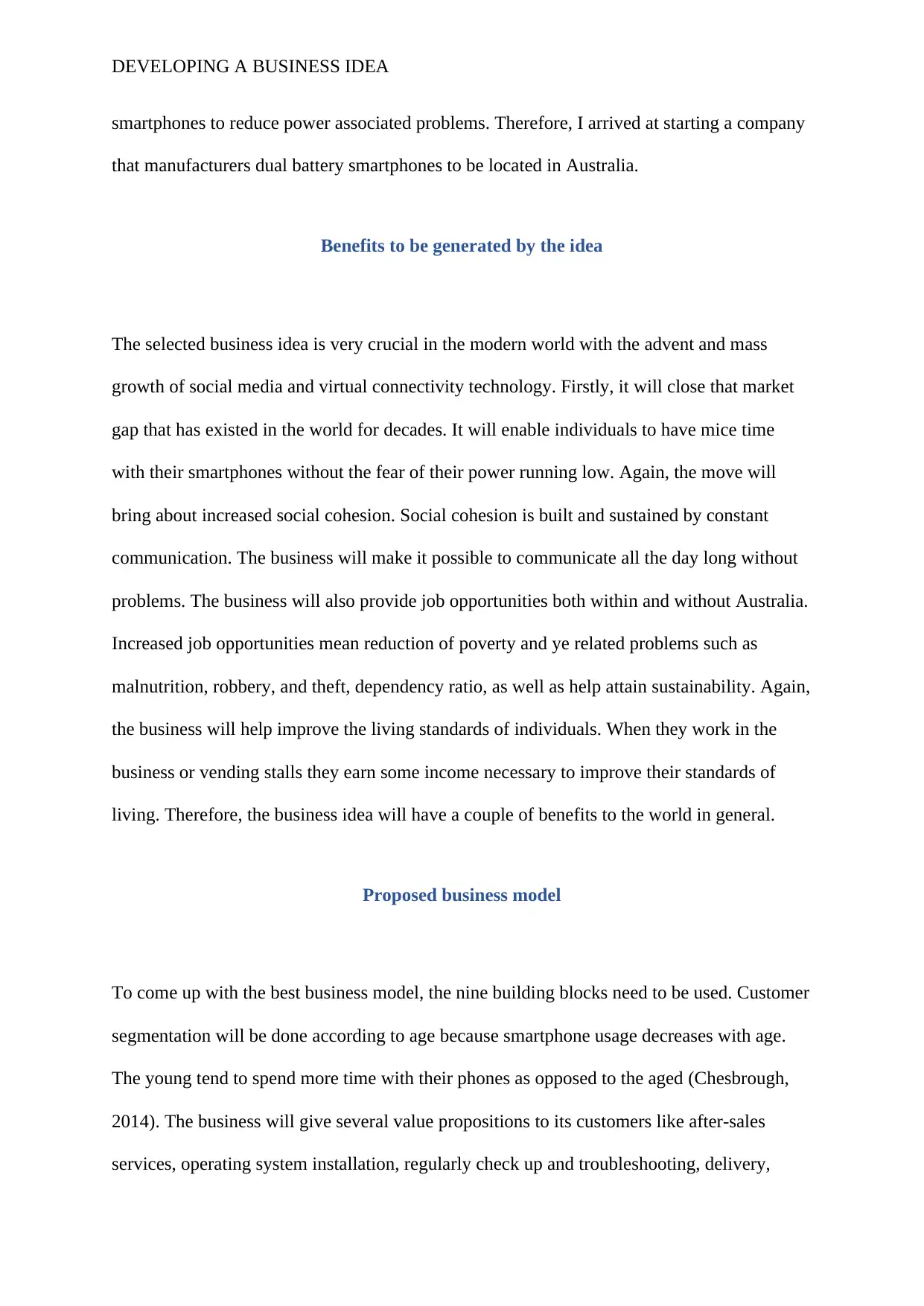
DEVELOPING A BUSINESS IDEA
smartphones to reduce power associated problems. Therefore, I arrived at starting a company
that manufacturers dual battery smartphones to be located in Australia.
Benefits to be generated by the idea
The selected business idea is very crucial in the modern world with the advent and mass
growth of social media and virtual connectivity technology. Firstly, it will close that market
gap that has existed in the world for decades. It will enable individuals to have mice time
with their smartphones without the fear of their power running low. Again, the move will
bring about increased social cohesion. Social cohesion is built and sustained by constant
communication. The business will make it possible to communicate all the day long without
problems. The business will also provide job opportunities both within and without Australia.
Increased job opportunities mean reduction of poverty and ye related problems such as
malnutrition, robbery, and theft, dependency ratio, as well as help attain sustainability. Again,
the business will help improve the living standards of individuals. When they work in the
business or vending stalls they earn some income necessary to improve their standards of
living. Therefore, the business idea will have a couple of benefits to the world in general.
Proposed business model
To come up with the best business model, the nine building blocks need to be used. Customer
segmentation will be done according to age because smartphone usage decreases with age.
The young tend to spend more time with their phones as opposed to the aged (Chesbrough,
2014). The business will give several value propositions to its customers like after-sales
services, operating system installation, regularly check up and troubleshooting, delivery,
smartphones to reduce power associated problems. Therefore, I arrived at starting a company
that manufacturers dual battery smartphones to be located in Australia.
Benefits to be generated by the idea
The selected business idea is very crucial in the modern world with the advent and mass
growth of social media and virtual connectivity technology. Firstly, it will close that market
gap that has existed in the world for decades. It will enable individuals to have mice time
with their smartphones without the fear of their power running low. Again, the move will
bring about increased social cohesion. Social cohesion is built and sustained by constant
communication. The business will make it possible to communicate all the day long without
problems. The business will also provide job opportunities both within and without Australia.
Increased job opportunities mean reduction of poverty and ye related problems such as
malnutrition, robbery, and theft, dependency ratio, as well as help attain sustainability. Again,
the business will help improve the living standards of individuals. When they work in the
business or vending stalls they earn some income necessary to improve their standards of
living. Therefore, the business idea will have a couple of benefits to the world in general.
Proposed business model
To come up with the best business model, the nine building blocks need to be used. Customer
segmentation will be done according to age because smartphone usage decreases with age.
The young tend to spend more time with their phones as opposed to the aged (Chesbrough,
2014). The business will give several value propositions to its customers like after-sales
services, operating system installation, regularly check up and troubleshooting, delivery,
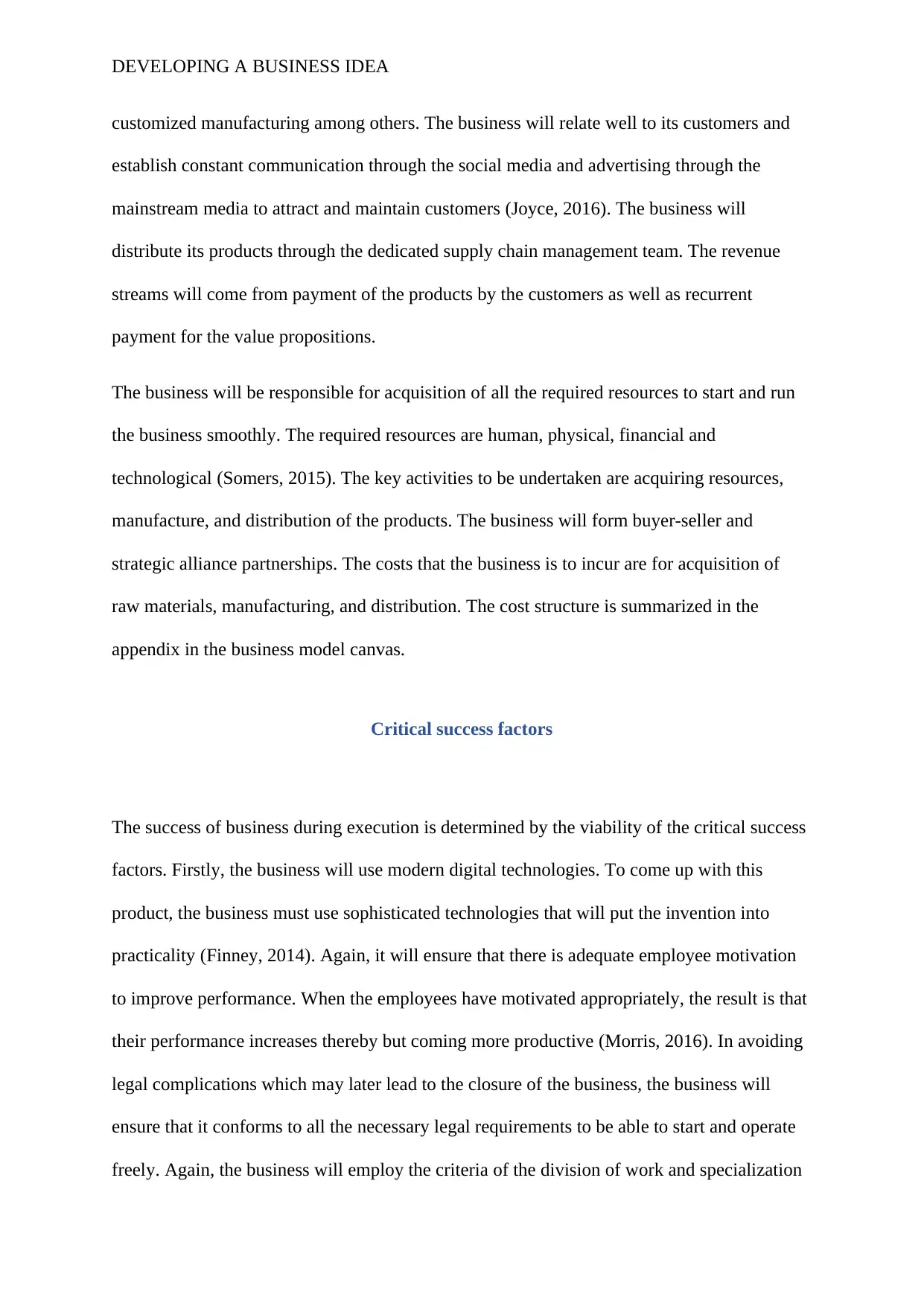
DEVELOPING A BUSINESS IDEA
customized manufacturing among others. The business will relate well to its customers and
establish constant communication through the social media and advertising through the
mainstream media to attract and maintain customers (Joyce, 2016). The business will
distribute its products through the dedicated supply chain management team. The revenue
streams will come from payment of the products by the customers as well as recurrent
payment for the value propositions.
The business will be responsible for acquisition of all the required resources to start and run
the business smoothly. The required resources are human, physical, financial and
technological (Somers, 2015). The key activities to be undertaken are acquiring resources,
manufacture, and distribution of the products. The business will form buyer-seller and
strategic alliance partnerships. The costs that the business is to incur are for acquisition of
raw materials, manufacturing, and distribution. The cost structure is summarized in the
appendix in the business model canvas.
Critical success factors
The success of business during execution is determined by the viability of the critical success
factors. Firstly, the business will use modern digital technologies. To come up with this
product, the business must use sophisticated technologies that will put the invention into
practicality (Finney, 2014). Again, it will ensure that there is adequate employee motivation
to improve performance. When the employees have motivated appropriately, the result is that
their performance increases thereby but coming more productive (Morris, 2016). In avoiding
legal complications which may later lead to the closure of the business, the business will
ensure that it conforms to all the necessary legal requirements to be able to start and operate
freely. Again, the business will employ the criteria of the division of work and specialization
customized manufacturing among others. The business will relate well to its customers and
establish constant communication through the social media and advertising through the
mainstream media to attract and maintain customers (Joyce, 2016). The business will
distribute its products through the dedicated supply chain management team. The revenue
streams will come from payment of the products by the customers as well as recurrent
payment for the value propositions.
The business will be responsible for acquisition of all the required resources to start and run
the business smoothly. The required resources are human, physical, financial and
technological (Somers, 2015). The key activities to be undertaken are acquiring resources,
manufacture, and distribution of the products. The business will form buyer-seller and
strategic alliance partnerships. The costs that the business is to incur are for acquisition of
raw materials, manufacturing, and distribution. The cost structure is summarized in the
appendix in the business model canvas.
Critical success factors
The success of business during execution is determined by the viability of the critical success
factors. Firstly, the business will use modern digital technologies. To come up with this
product, the business must use sophisticated technologies that will put the invention into
practicality (Finney, 2014). Again, it will ensure that there is adequate employee motivation
to improve performance. When the employees have motivated appropriately, the result is that
their performance increases thereby but coming more productive (Morris, 2016). In avoiding
legal complications which may later lead to the closure of the business, the business will
ensure that it conforms to all the necessary legal requirements to be able to start and operate
freely. Again, the business will employ the criteria of the division of work and specialization
⊘ This is a preview!⊘
Do you want full access?
Subscribe today to unlock all pages.

Trusted by 1+ million students worldwide
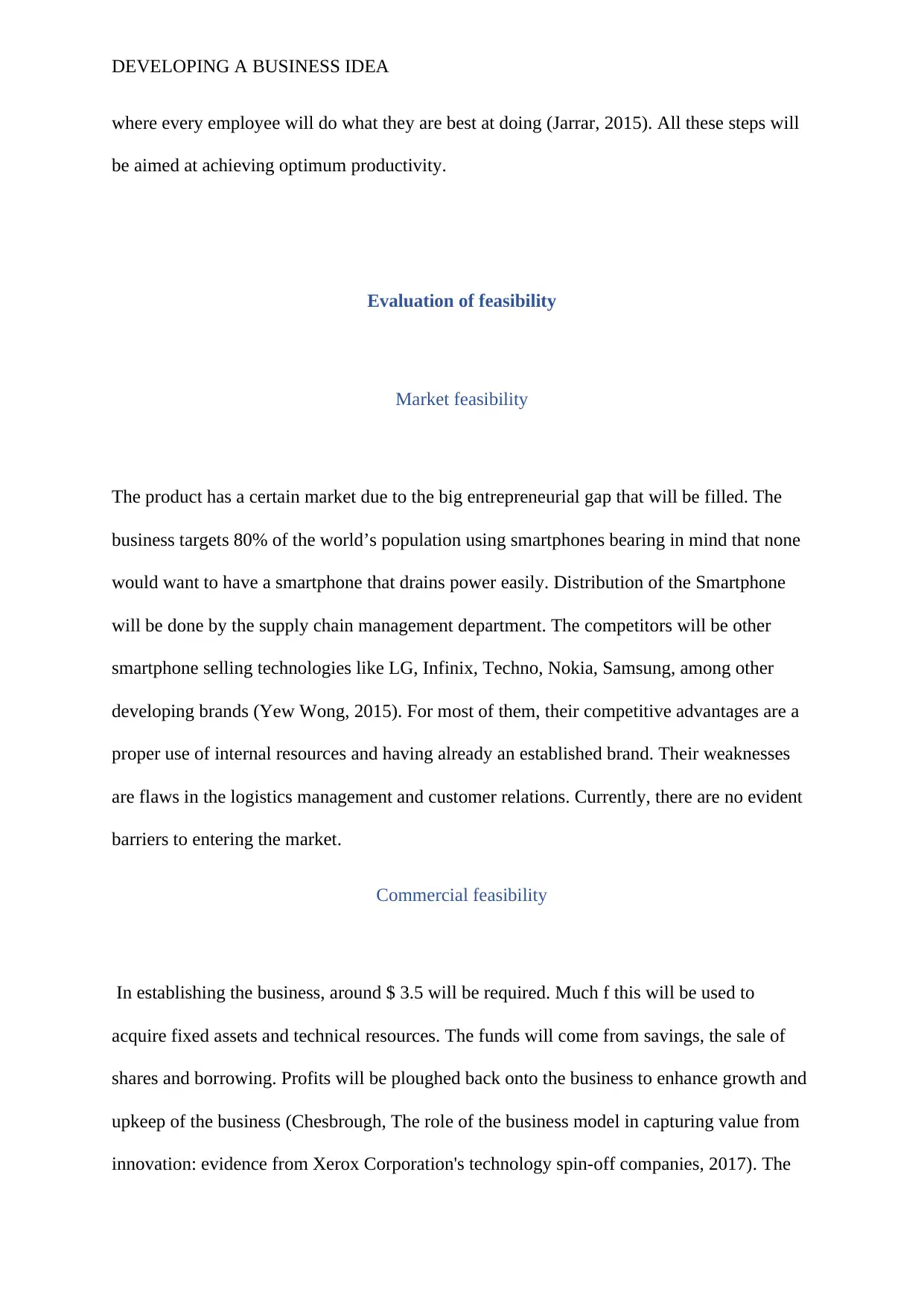
DEVELOPING A BUSINESS IDEA
where every employee will do what they are best at doing (Jarrar, 2015). All these steps will
be aimed at achieving optimum productivity.
Evaluation of feasibility
Market feasibility
The product has a certain market due to the big entrepreneurial gap that will be filled. The
business targets 80% of the world’s population using smartphones bearing in mind that none
would want to have a smartphone that drains power easily. Distribution of the Smartphone
will be done by the supply chain management department. The competitors will be other
smartphone selling technologies like LG, Infinix, Techno, Nokia, Samsung, among other
developing brands (Yew Wong, 2015). For most of them, their competitive advantages are a
proper use of internal resources and having already an established brand. Their weaknesses
are flaws in the logistics management and customer relations. Currently, there are no evident
barriers to entering the market.
Commercial feasibility
In establishing the business, around $ 3.5 will be required. Much f this will be used to
acquire fixed assets and technical resources. The funds will come from savings, the sale of
shares and borrowing. Profits will be ploughed back onto the business to enhance growth and
upkeep of the business (Chesbrough, The role of the business model in capturing value from
innovation: evidence from Xerox Corporation's technology spin‐off companies, 2017). The
where every employee will do what they are best at doing (Jarrar, 2015). All these steps will
be aimed at achieving optimum productivity.
Evaluation of feasibility
Market feasibility
The product has a certain market due to the big entrepreneurial gap that will be filled. The
business targets 80% of the world’s population using smartphones bearing in mind that none
would want to have a smartphone that drains power easily. Distribution of the Smartphone
will be done by the supply chain management department. The competitors will be other
smartphone selling technologies like LG, Infinix, Techno, Nokia, Samsung, among other
developing brands (Yew Wong, 2015). For most of them, their competitive advantages are a
proper use of internal resources and having already an established brand. Their weaknesses
are flaws in the logistics management and customer relations. Currently, there are no evident
barriers to entering the market.
Commercial feasibility
In establishing the business, around $ 3.5 will be required. Much f this will be used to
acquire fixed assets and technical resources. The funds will come from savings, the sale of
shares and borrowing. Profits will be ploughed back onto the business to enhance growth and
upkeep of the business (Chesbrough, The role of the business model in capturing value from
innovation: evidence from Xerox Corporation's technology spin‐off companies, 2017). The
Paraphrase This Document
Need a fresh take? Get an instant paraphrase of this document with our AI Paraphraser
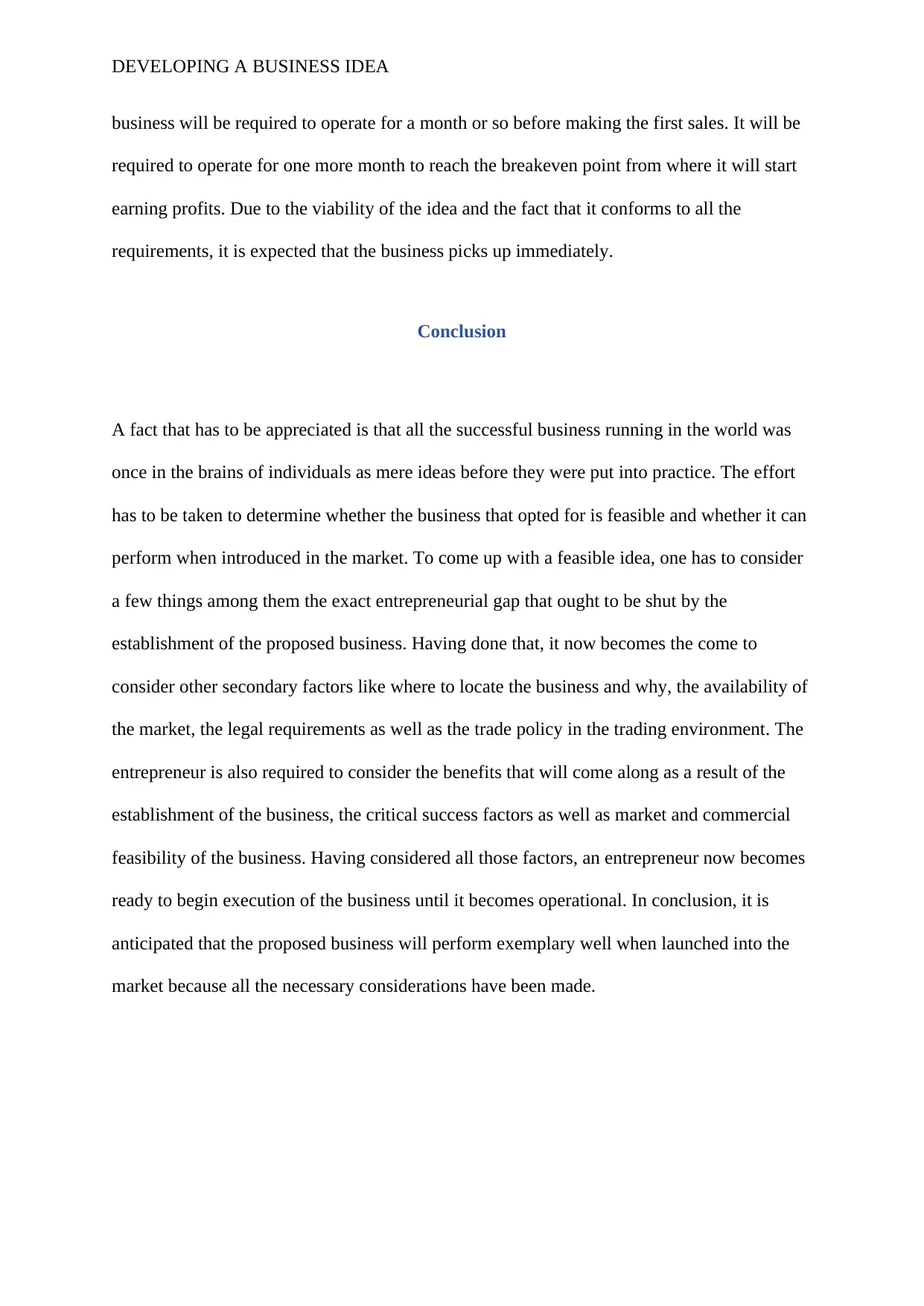
DEVELOPING A BUSINESS IDEA
business will be required to operate for a month or so before making the first sales. It will be
required to operate for one more month to reach the breakeven point from where it will start
earning profits. Due to the viability of the idea and the fact that it conforms to all the
requirements, it is expected that the business picks up immediately.
Conclusion
A fact that has to be appreciated is that all the successful business running in the world was
once in the brains of individuals as mere ideas before they were put into practice. The effort
has to be taken to determine whether the business that opted for is feasible and whether it can
perform when introduced in the market. To come up with a feasible idea, one has to consider
a few things among them the exact entrepreneurial gap that ought to be shut by the
establishment of the proposed business. Having done that, it now becomes the come to
consider other secondary factors like where to locate the business and why, the availability of
the market, the legal requirements as well as the trade policy in the trading environment. The
entrepreneur is also required to consider the benefits that will come along as a result of the
establishment of the business, the critical success factors as well as market and commercial
feasibility of the business. Having considered all those factors, an entrepreneur now becomes
ready to begin execution of the business until it becomes operational. In conclusion, it is
anticipated that the proposed business will perform exemplary well when launched into the
market because all the necessary considerations have been made.
business will be required to operate for a month or so before making the first sales. It will be
required to operate for one more month to reach the breakeven point from where it will start
earning profits. Due to the viability of the idea and the fact that it conforms to all the
requirements, it is expected that the business picks up immediately.
Conclusion
A fact that has to be appreciated is that all the successful business running in the world was
once in the brains of individuals as mere ideas before they were put into practice. The effort
has to be taken to determine whether the business that opted for is feasible and whether it can
perform when introduced in the market. To come up with a feasible idea, one has to consider
a few things among them the exact entrepreneurial gap that ought to be shut by the
establishment of the proposed business. Having done that, it now becomes the come to
consider other secondary factors like where to locate the business and why, the availability of
the market, the legal requirements as well as the trade policy in the trading environment. The
entrepreneur is also required to consider the benefits that will come along as a result of the
establishment of the business, the critical success factors as well as market and commercial
feasibility of the business. Having considered all those factors, an entrepreneur now becomes
ready to begin execution of the business until it becomes operational. In conclusion, it is
anticipated that the proposed business will perform exemplary well when launched into the
market because all the necessary considerations have been made.
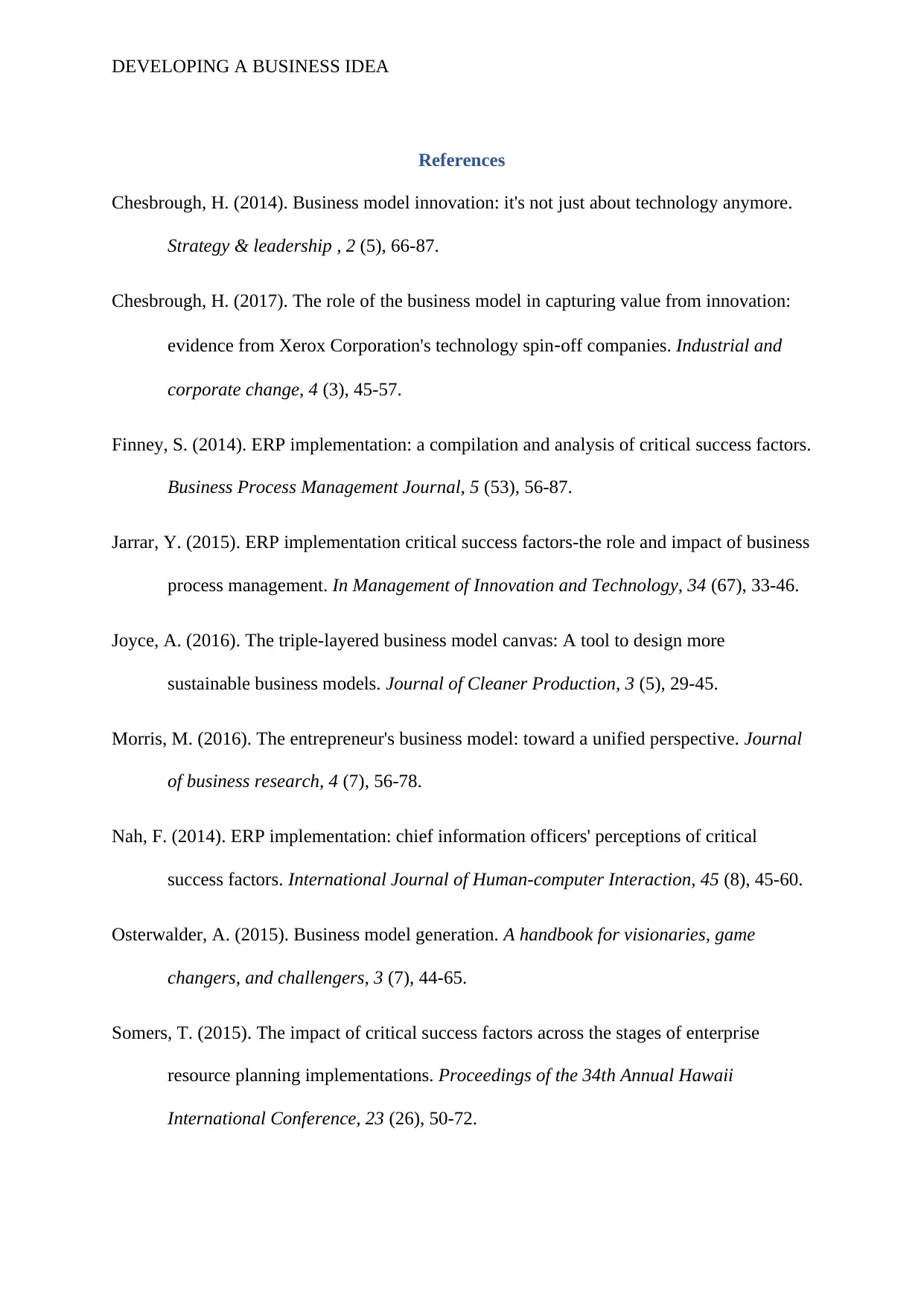
DEVELOPING A BUSINESS IDEA
References
Chesbrough, H. (2014). Business model innovation: it's not just about technology anymore.
Strategy & leadership , 2 (5), 66-87.
Chesbrough, H. (2017). The role of the business model in capturing value from innovation:
evidence from Xerox Corporation's technology spin‐off companies. Industrial and
corporate change, 4 (3), 45-57.
Finney, S. (2014). ERP implementation: a compilation and analysis of critical success factors.
Business Process Management Journal, 5 (53), 56-87.
Jarrar, Y. (2015). ERP implementation critical success factors-the role and impact of business
process management. In Management of Innovation and Technology, 34 (67), 33-46.
Joyce, A. (2016). The triple-layered business model canvas: A tool to design more
sustainable business models. Journal of Cleaner Production, 3 (5), 29-45.
Morris, M. (2016). The entrepreneur's business model: toward a unified perspective. Journal
of business research, 4 (7), 56-78.
Nah, F. (2014). ERP implementation: chief information officers' perceptions of critical
success factors. International Journal of Human-computer Interaction, 45 (8), 45-60.
Osterwalder, A. (2015). Business model generation. A handbook for visionaries, game
changers, and challengers, 3 (7), 44-65.
Somers, T. (2015). The impact of critical success factors across the stages of enterprise
resource planning implementations. Proceedings of the 34th Annual Hawaii
International Conference, 23 (26), 50-72.
References
Chesbrough, H. (2014). Business model innovation: it's not just about technology anymore.
Strategy & leadership , 2 (5), 66-87.
Chesbrough, H. (2017). The role of the business model in capturing value from innovation:
evidence from Xerox Corporation's technology spin‐off companies. Industrial and
corporate change, 4 (3), 45-57.
Finney, S. (2014). ERP implementation: a compilation and analysis of critical success factors.
Business Process Management Journal, 5 (53), 56-87.
Jarrar, Y. (2015). ERP implementation critical success factors-the role and impact of business
process management. In Management of Innovation and Technology, 34 (67), 33-46.
Joyce, A. (2016). The triple-layered business model canvas: A tool to design more
sustainable business models. Journal of Cleaner Production, 3 (5), 29-45.
Morris, M. (2016). The entrepreneur's business model: toward a unified perspective. Journal
of business research, 4 (7), 56-78.
Nah, F. (2014). ERP implementation: chief information officers' perceptions of critical
success factors. International Journal of Human-computer Interaction, 45 (8), 45-60.
Osterwalder, A. (2015). Business model generation. A handbook for visionaries, game
changers, and challengers, 3 (7), 44-65.
Somers, T. (2015). The impact of critical success factors across the stages of enterprise
resource planning implementations. Proceedings of the 34th Annual Hawaii
International Conference, 23 (26), 50-72.
⊘ This is a preview!⊘
Do you want full access?
Subscribe today to unlock all pages.

Trusted by 1+ million students worldwide
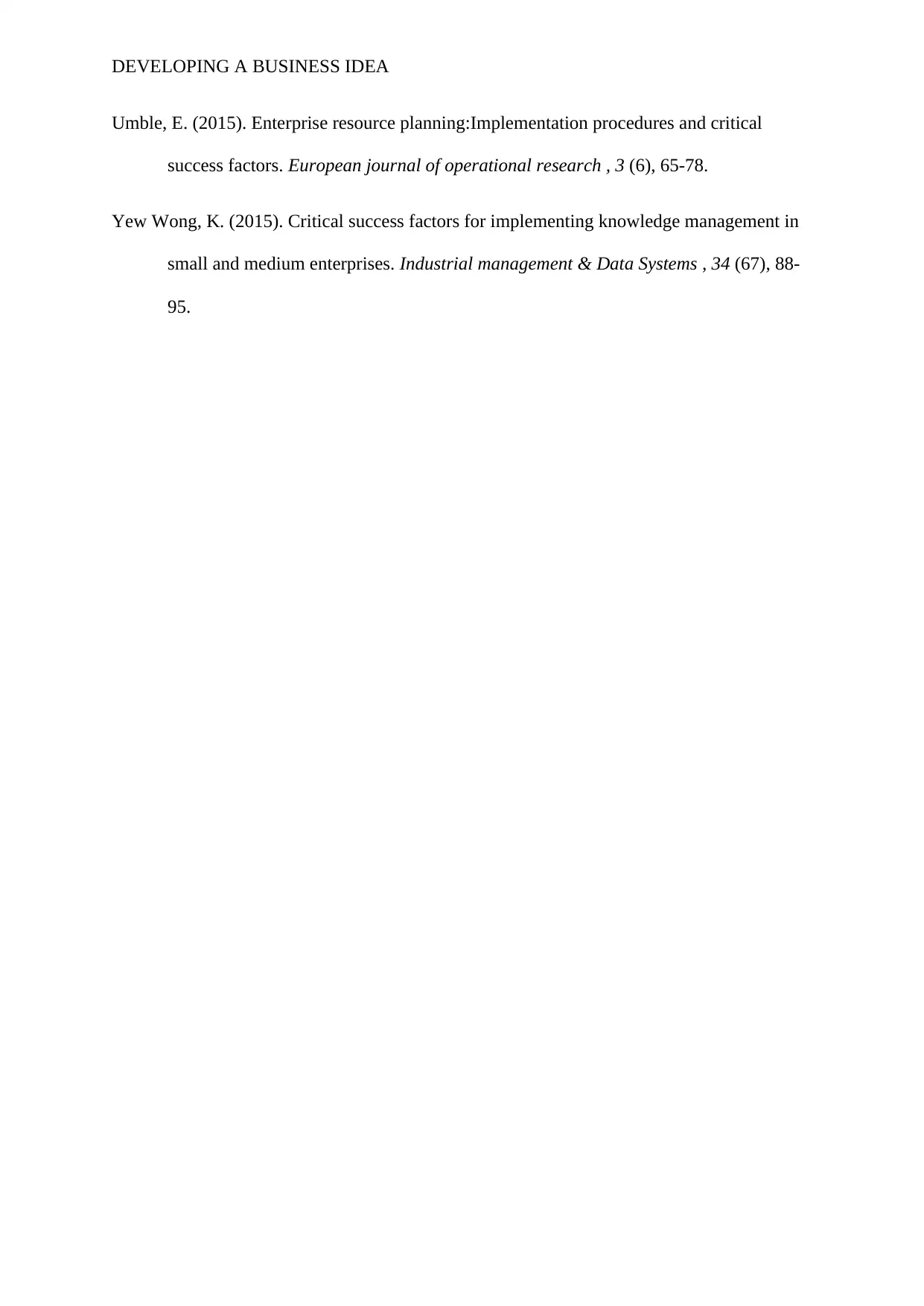
DEVELOPING A BUSINESS IDEA
Umble, E. (2015). Enterprise resource planning:Implementation procedures and critical
success factors. European journal of operational research , 3 (6), 65-78.
Yew Wong, K. (2015). Critical success factors for implementing knowledge management in
small and medium enterprises. Industrial management & Data Systems , 34 (67), 88-
95.
Umble, E. (2015). Enterprise resource planning:Implementation procedures and critical
success factors. European journal of operational research , 3 (6), 65-78.
Yew Wong, K. (2015). Critical success factors for implementing knowledge management in
small and medium enterprises. Industrial management & Data Systems , 34 (67), 88-
95.
Paraphrase This Document
Need a fresh take? Get an instant paraphrase of this document with our AI Paraphraser
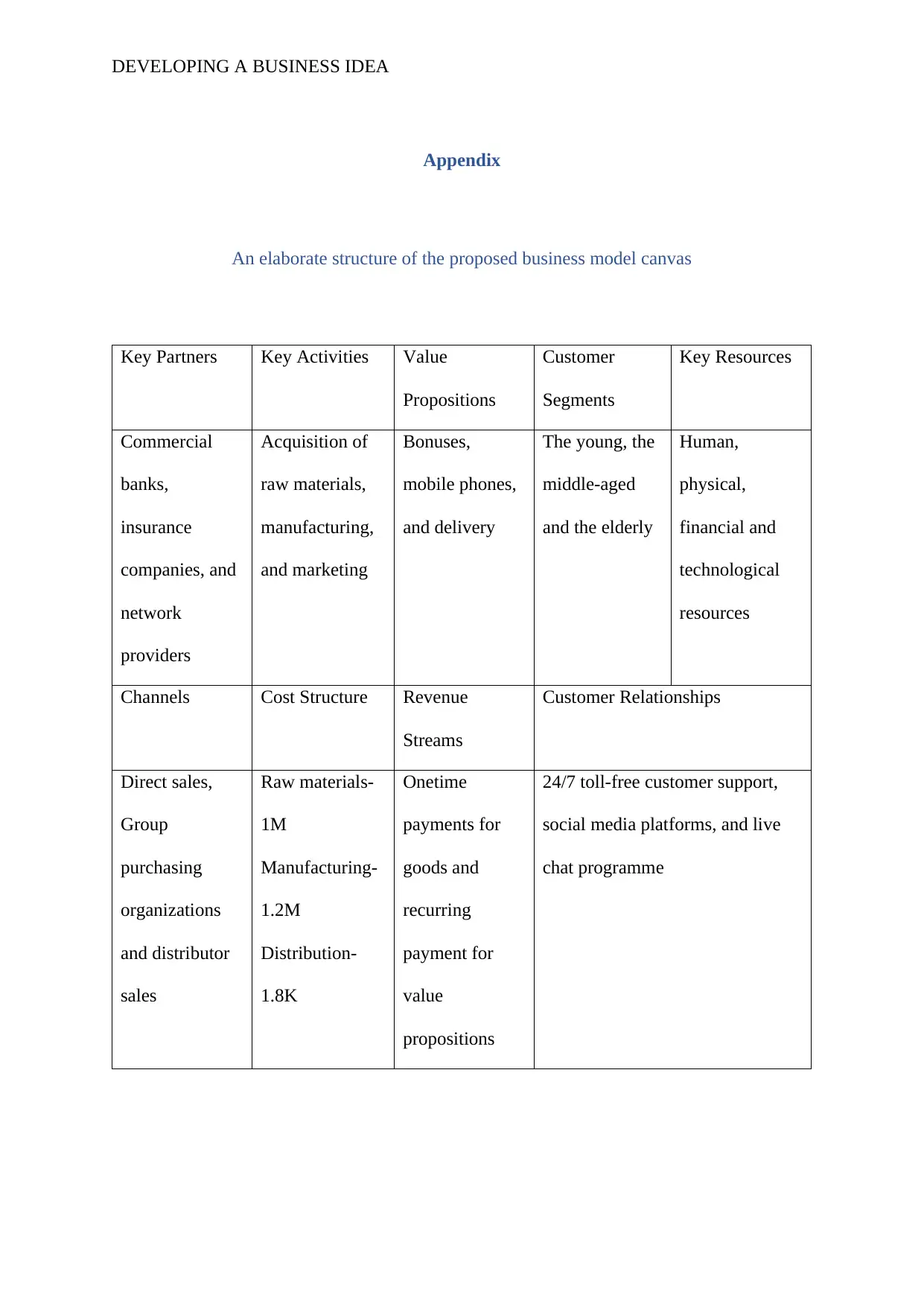
DEVELOPING A BUSINESS IDEA
Appendix
An elaborate structure of the proposed business model canvas
Key Partners Key Activities Value
Propositions
Customer
Segments
Key Resources
Commercial
banks,
insurance
companies, and
network
providers
Acquisition of
raw materials,
manufacturing,
and marketing
Bonuses,
mobile phones,
and delivery
The young, the
middle-aged
and the elderly
Human,
physical,
financial and
technological
resources
Channels Cost Structure Revenue
Streams
Customer Relationships
Direct sales,
Group
purchasing
organizations
and distributor
sales
Raw materials-
1M
Manufacturing-
1.2M
Distribution-
1.8K
Onetime
payments for
goods and
recurring
payment for
value
propositions
24/7 toll-free customer support,
social media platforms, and live
chat programme
Appendix
An elaborate structure of the proposed business model canvas
Key Partners Key Activities Value
Propositions
Customer
Segments
Key Resources
Commercial
banks,
insurance
companies, and
network
providers
Acquisition of
raw materials,
manufacturing,
and marketing
Bonuses,
mobile phones,
and delivery
The young, the
middle-aged
and the elderly
Human,
physical,
financial and
technological
resources
Channels Cost Structure Revenue
Streams
Customer Relationships
Direct sales,
Group
purchasing
organizations
and distributor
sales
Raw materials-
1M
Manufacturing-
1.2M
Distribution-
1.8K
Onetime
payments for
goods and
recurring
payment for
value
propositions
24/7 toll-free customer support,
social media platforms, and live
chat programme
1 out of 11
Related Documents
Your All-in-One AI-Powered Toolkit for Academic Success.
+13062052269
info@desklib.com
Available 24*7 on WhatsApp / Email
![[object Object]](/_next/static/media/star-bottom.7253800d.svg)
Unlock your academic potential
Copyright © 2020–2025 A2Z Services. All Rights Reserved. Developed and managed by ZUCOL.





